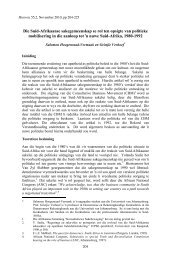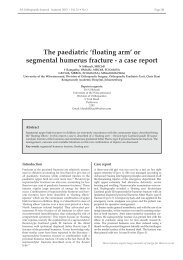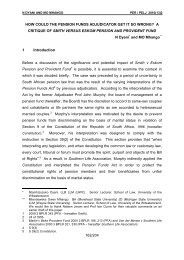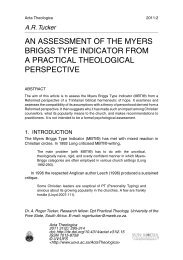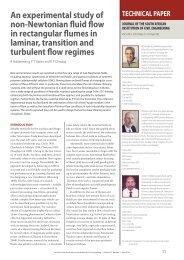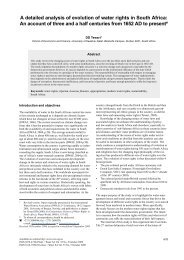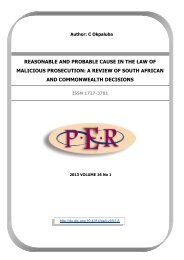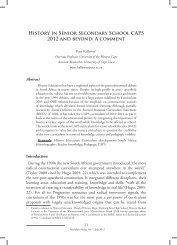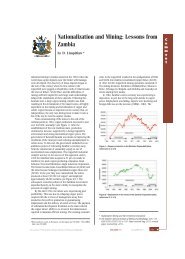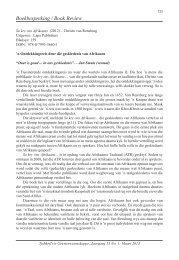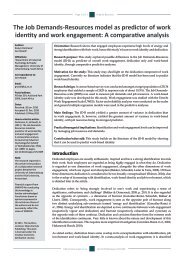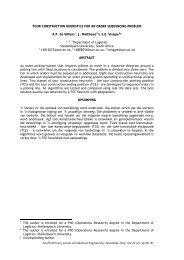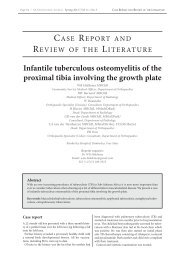The Union of South Africa censuses 1911â1960: An incomplete record
The Union of South Africa censuses 1911â1960: An incomplete record
The Union of South Africa censuses 1911â1960: An incomplete record
Create successful ePaper yourself
Turn your PDF publications into a flip-book with our unique Google optimized e-Paper software.
Historia 56, 2, November 2011, pp 1–18<br />
Introduction<br />
<strong>The</strong> <strong>Union</strong> <strong>of</strong> <strong>South</strong> <strong>Africa</strong> <strong>censuses</strong> 1911–1960:<br />
<strong>An</strong> <strong>incomplete</strong> <strong>record</strong><br />
A.J. Christopher <br />
<strong>The</strong> census is one <strong>of</strong> the most intrusive and comprehensive investigations undertaken by<br />
the state in its quest for information concerning the population which it controls and<br />
serves. 1 <strong>The</strong> information sought is more than a mere headcount. It reflects the <strong>of</strong>ficial<br />
need for statistics on a wide range <strong>of</strong> human activities and attributes, in order to execute<br />
the functions <strong>of</strong> the modern bureaucratic state because it came into being in the<br />
nineteenth and twentieth centuries. 2 Census questionnaires require not only purely<br />
demographic statistics on the number <strong>of</strong> people by sex, age and marital status, but also<br />
economic information on education, occupation, and income and most contentiously on<br />
questions <strong>of</strong> identity including race, language, religion and nationality. 3 Indeed it was the<br />
census authorities who through the collection and tabulation <strong>of</strong> vast quantities <strong>of</strong><br />
individual items <strong>of</strong> data, provided: “the descriptions which ‘speak to power’ with ‘useful’<br />
information”. 4 In order to make the data intelligible to the state bureaucracy it was<br />
necessary to simplify and to classify the population into defined categories or groups, for<br />
which the census authorities also possessed the prerogative <strong>of</strong> naming. 5<br />
<strong>The</strong> national census organisation constitutes a major and powerful governmental<br />
enterprise, which has become the subject <strong>of</strong> enquiry in itself. This is particularly the case<br />
in the United States, where the uninterrupted sequence <strong>of</strong> decennial enumerations which<br />
began in 1790, has been the object <strong>of</strong> intensive scrutiny, particularly in its handling <strong>of</strong> the<br />
issue <strong>of</strong> race. 6 It has been noted that the census was one <strong>of</strong> the key elements in the<br />
<br />
<strong>An</strong>thony Christopher is Pr<strong>of</strong>essor Emeritus <strong>of</strong> Geography at Nelson Mandela Metropolitan<br />
University, Port Elizabeth. His research interests include an examination <strong>of</strong> the census <strong>record</strong>s <strong>of</strong><br />
the British Empire and Commonwealth. <strong>The</strong> financial assistance <strong>of</strong> the National Research<br />
Foundation towards the costs <strong>of</strong> this research is hereby acknowledged. <strong>The</strong> opinions expressed<br />
and the conclusions arrived at are those <strong>of</strong> the author and should not necessarily be attributed to<br />
the National Research Foundation.<br />
1. J.C. Scott, Seeing Like a State: How Certain Schemes to Improve the Human Condition Have Failed (Yale<br />
University Press, New Haven, 1998), pp 11–83.<br />
2. E. Higgs, “<strong>The</strong> Rise <strong>of</strong> the Information State: <strong>The</strong> Development <strong>of</strong> Central State Surveillance <strong>of</strong><br />
the Citizen in England 1500–2000”, Journal <strong>of</strong> Historical Sociology, 14, 2001, pp 175–197.<br />
3. D.I. Kertzer and D. Arel, Census and Identity: <strong>The</strong> Politics <strong>of</strong> Race, Ethnicity and Languages in National<br />
Censuses (Cambridge University Press, Cambridge, 2002), pp 1–42.<br />
4. S. Szreter, H. Sholkamy, and A. Dharmalingam, Categories and Contexts: <strong>An</strong>thropological and Historical<br />
Studies in Critical Demography (Oxford University Press, Oxford, 2004), p 16.<br />
5. W. Safran, “Names, Labels, and Identities: Sociopolitical Contexts and the Question <strong>of</strong> Ethnic<br />
Categorization”, Identities, 15, 2008, pp 437–461.<br />
6. M.J. <strong>An</strong>derson, <strong>The</strong> American Census: A Social History (Yale University Press, New Haven, 1988);<br />
M.J. <strong>An</strong>derson and S.E. Fienberg, Who Counts? <strong>The</strong> Politics <strong>of</strong> Census-taking in Contemporary America<br />
(Russell Sage, New York, 1999); M.G. Hannah, Governmentality and the Mastery <strong>of</strong> Territory in<br />
Nineteenth-Century America (Cambridge University Press, Cambridge, 2000); D.S. Hillygus, N.H.<br />
Nie, K. Prewitt and H. Pals, <strong>The</strong> Hard Count: <strong>The</strong> Political and Social Challenges <strong>of</strong> Census Mobilization<br />
(Russell Sage, New York, 2006); M. Nobles, Shades <strong>of</strong> Citizenship: Race and the Census in Modern<br />
Politics (Stanford University Press, Stanford, 2000); J. Perlmann and M. Waters, <strong>The</strong> New Race<br />
Question: How the Census Counts Multiracial Individuals (Russell Sage, New York, 2002); C.E.<br />
Rodriguez, Changing Race: Latinos, the Census and the History <strong>of</strong> Ethnicity in the United States (New York<br />
University Press, New York, 2000); K.M. Williams, Mark One or More: Civil Rights in Multiracial<br />
America (University <strong>of</strong> Michigan Press, <strong>An</strong>n Arbor, 2006).<br />
1
Christopher – <strong>Union</strong> <strong>of</strong> <strong>South</strong> <strong>Africa</strong> <strong>censuses</strong><br />
definition <strong>of</strong> the modern nation-state through the collection <strong>of</strong> unified data and the<br />
adoption <strong>of</strong> common classification schemes, paralleling the survey and mapping <strong>of</strong> the<br />
territory <strong>of</strong> the state, whether nineteenth-century England or post-colonial Asia. 7 Similar<br />
developments have also been identified in states traditionally organised on confessional<br />
lines undergoing modernisation in the nineteenth century. 8 In the twentieth century the<br />
Soviet census organisation played a vital part in the development <strong>of</strong> the category<br />
“nationality” and the forging <strong>of</strong> a new nation. 9 Similarly in Nazi Germany and its<br />
occupied countries the census was a key to the identification and monitoring <strong>of</strong> people,<br />
most notably the Jewish population. 10 More recently the <strong>censuses</strong> have played a<br />
significant role in the definition <strong>of</strong> the state and nation in the post-Soviet republics<br />
seeking to establish their own separate identities. 11<br />
<strong>The</strong> state’s quest for information was as intense in the colonies as in the<br />
metropolitan countries. 12 It has been suggested that numbering and classification were<br />
essential parts <strong>of</strong> the colonial project. 13 Indeed, in the colonies census commissioners<br />
were able to conduct enquiries into topics, notably those <strong>of</strong> identity, which were not<br />
possible in the United Kingdom. Furthermore, the census was not a neutral observer, but<br />
helped to create a new society, through the imposition <strong>of</strong> statistical order upon the<br />
population. 14 It has been suggested that:<br />
Individuals find themselves firmly fixed as members in various groups <strong>of</strong> a<br />
particular dimension and substance. Thus the census imposes order and order <strong>of</strong> a<br />
statistical nature. In time the creation <strong>of</strong> a new ordering <strong>of</strong> society will act to<br />
reshape that which the census sought to merely describe. 15<br />
Within the British Empire, the role <strong>of</strong> the census in the demographic ordering <strong>of</strong> the<br />
population <strong>of</strong> India has been extensively examined. 16 <strong>The</strong> presence <strong>of</strong> a substantial<br />
7. B. <strong>An</strong>derson, Imagined Communities: Reflections on the Origin and Spread <strong>of</strong> Nationalism (Verso, London,<br />
1991), pp 163–185; E. Higgs, Life, Death and Statistics: Civil Registration, Censuses and the Work <strong>of</strong> the<br />
General Register Office 1836–1952 (University <strong>of</strong> Hertfordshire, Hatfield, 2004), p vii.<br />
8. G. Alleaume and P. Fargues, “La Naissance d’une Statistique d’État. Le Recensement de 1848 en<br />
Égypte”, Histoire et Mesure, 13, 1/2, 1998, pp 147–193; S.J. Shaw, “<strong>The</strong> Ottoman Census System<br />
and Population 1831–1914”, International Journal <strong>of</strong> Middle East Studies, 9, 1978, pp 325–338.<br />
9. F. Hirsch, “<strong>The</strong> Soviet <strong>Union</strong> as Work-in-Progress: Ethnographers and the Category ‘Nationality’<br />
in the 1926, 1937 and 1939 Censuses”, Slavic Review, 56, 1997, pp 251–278; E. Hirsch, Empire <strong>of</strong><br />
Nations: Ethnographic Knowledge and the Making <strong>of</strong> the Soviet <strong>Union</strong> (Cornell University Press, Ithaca,<br />
2005), p 14.<br />
10. G. Aly and K.H. Roth, <strong>The</strong> Nazi Census: Identification and Control in the Third Reich (Temple<br />
University Press, Philadelphia, 2004), pp 56–93.<br />
11. D. Arel, “Demography and Politics in the First post-Soviet Censuses: Mistrusted State, Contested<br />
Identities”, Population-E, 57, 2002, pp 801–827; D. Arel, “Interpreting ‘Nationality’ and ‘Language’<br />
in the 2001 Ukrainian Census”, Post-Soviet Affairs, 18, 2002, pp 213–249; B. Dave, “Entitlement<br />
Through Numbers: Nationality and Language Categories in the First post-Soviet Census <strong>of</strong><br />
Kazakhstan”, Nations and Nationalism, 10, 2004, pp 439–459; G. Uehling, “<strong>The</strong> First Independent<br />
Ukrainian Census in Crimea: Myths, Miscoding and Missed Opportunities”, Ethnic and Racial<br />
Studies, 27, 2004, pp 149–170.<br />
12. A.J. Christopher, “<strong>The</strong> Quest for a Census <strong>of</strong> the British Empire c1840–1940”, Journal <strong>of</strong> Historical<br />
Geography, 34, 2008, pp 268–285.<br />
13. A. Appadurai, “Numbers in the Colonial Imagination”, in C.A. Breckenridge and P. van der Veer<br />
(eds), Orientalism and the Postcolonial Predicament: Perspectives on <strong>South</strong> Asia (University <strong>of</strong> Pennsylvania<br />
Press, Philadelphia, 1993), pp 314–340.<br />
14. B.S. Cohn, “<strong>The</strong> Census and Objectification in <strong>South</strong> Asia”, in B.S. Cohn (ed.), <strong>An</strong> <strong>An</strong>thropologist<br />
among the Historians and Other Essays (Oxford University Press, Delhi, 1981), pp 73–101.<br />
15. K.W. Jones, “Religious Identity and the Indian Census”, in N.G. Barrier (ed.), <strong>The</strong> Census in British<br />
India: New Perspectives (Manohar, New Delhi, 1981), p 75.<br />
16. Barrier, <strong>The</strong> Census in British India; S. Maheshwari, <strong>The</strong> Census Administration under the Raj and after<br />
2
Christopher – <strong>Union</strong> <strong>of</strong> <strong>South</strong> <strong>Africa</strong> <strong>censuses</strong><br />
literate indigenous bureaucracy which was essential to the pursuit <strong>of</strong> this level <strong>of</strong><br />
documentation as it was in the United Kingdom and the other dominions. However, it<br />
was lacking in the <strong>Africa</strong>n colonies. Thus British colonial <strong>censuses</strong> in <strong>Africa</strong> did not<br />
achieve anything comparable with those <strong>of</strong> India. As late as 1946, the Colonial Office<br />
complained about the lack <strong>of</strong> enumerations <strong>of</strong> the <strong>Africa</strong>n population. 17 Detailed analysis<br />
demonstrated how far most <strong>of</strong> the <strong>Africa</strong>n colonial <strong>censuses</strong> were from a comprehensive<br />
survey suggested as the colonial ideal. 18 On the other hand the <strong>censuses</strong> held in the West<br />
Indies did approach the inclusiveness sought in the United Kingdom. 19 Nevertheless, it<br />
was with the other dominions that <strong>South</strong> <strong>Africa</strong> might be compared, and with which its<br />
statistical <strong>of</strong>ficers shared experience and Commonwealth conferences. In this respect the<br />
<strong>record</strong> was mixed. <strong>The</strong> census <strong>of</strong> Canada was a comprehensive enterprise which had<br />
included the indigenous population as part <strong>of</strong> the national inventory since the nineteenth<br />
century. 20 That <strong>of</strong> Australia excluded the Aboriginal population from the census returns<br />
under a constitutional provision until 1967. 21 In New Zealand, separate Maori <strong>censuses</strong><br />
with separate questionnaires had been conducted until 1951 and separate reports<br />
continued thereafter. 22<br />
<strong>The</strong> census in <strong>South</strong> <strong>Africa</strong> has received comparatively little attention beyond the<br />
use <strong>of</strong> its data. <strong>The</strong> sequence <strong>of</strong> <strong>censuses</strong> was irregular and the coverage unsystematic<br />
during the nineteenth century. <strong>The</strong> Cape <strong>of</strong> Good Hope conducted the first modern<br />
scientific census in 1865, following the principles laid down by the British Colonial<br />
Office and repeated the exercise in 1875 and 1891. 23 <strong>The</strong> Orange Free State followed in<br />
1880 and 1890, copying many <strong>of</strong> the features <strong>of</strong> the Cape <strong>of</strong> Good Hope. 24 <strong>The</strong> <strong>South</strong><br />
<strong>Africa</strong>n Republic (Transvaal) followed in 1890. 25 However, the enumeration was<br />
restricted to the White population. 26 Finally, in 1891 Natal conducted a partial<br />
enumeration. 27 <strong>The</strong> information demanded varied substantially and the final reports<br />
ranged from a few pages to several hundred. After the <strong>South</strong> <strong>Africa</strong>n War <strong>of</strong> 1899–1902,<br />
all the colonies undertook <strong>censuses</strong> in April 1904, but although broad coordination took<br />
place the results were presented according to the views <strong>of</strong> the four individual census<br />
(Concept, New Delhi, 1996); S.P. Mohanty and A.R. Momin, Census as Social Document (Rawat,<br />
Jaipur, 1996); S.C. Srivastava, Indian Census in Perspective (Office <strong>of</strong> the Registrar General, New<br />
Delhi, 1972).<br />
17. Colonial Social Science Research Council, Demography and the Census in the Colonies (Colonial Office,<br />
London, 1946), p 5.<br />
18. R.R. Kuczynski, Demographic Survey <strong>of</strong> the British Colonial Empire, Volume I, West <strong>Africa</strong> (Oxford<br />
University Press, London, 1948); R.R. Kuczynski, Demographic Survey <strong>of</strong> the British Colonial Empire,<br />
Volume II, East <strong>Africa</strong> (Oxford University Press, London, 1949).<br />
19. R.R. Kuczynski, Demographic Survey <strong>of</strong> the British Colonial Empire, Volume III, West Indian and American<br />
Territories (Oxford University Press, London, 1953).<br />
20. B. Curtis, <strong>The</strong> Politics <strong>of</strong> Population: State Formation, Statistics and the Census <strong>of</strong> Canada, 1840–1875<br />
(University <strong>of</strong> Toronto Press, Toronto, 2001), pp 192–194.<br />
21. L.G. Hopkins, <strong>The</strong> Australian Population Census (Library <strong>of</strong> Parliament, Canberra, 1983), p 3.<br />
22. New Zealand, Population Census 1951, Volume 8 Report (Department <strong>of</strong> Census and Statistics,<br />
Wellington, 1956), p 1.<br />
23. G20-’66, Census <strong>of</strong> the Colony <strong>of</strong> the Cape <strong>of</strong> Good Hope 1865 (Government Printer, Cape Town, 1866);<br />
G42-’76, Census <strong>of</strong> the Colony <strong>of</strong> the Cape <strong>of</strong> Good Hope 1875, Part I Summaries (Government Printer,<br />
Cape Town, 1877); G6-’92, Census <strong>of</strong> the Colony <strong>of</strong> the Cape <strong>of</strong> Good Hope 1891 (Government Printer,<br />
Cape Town, 1892).<br />
24. Verslag van den Census, 1890 (C. Borckenhagen, Bloemfontein, 1890).<br />
25. Verslag van de Volkstelling, 1890 (Staatsdrukker, Pretoria, 1891).<br />
26. Race classification has dominated census taking. In this paper contemporary usages have been<br />
adopted, where appropriate, and elsewhere the present post-apartheid, four-fold nomenclature <strong>of</strong><br />
<strong>Africa</strong>n, Coloured, Indian and White.<br />
27. Census <strong>of</strong> the Colony <strong>of</strong> Natal 1891 (Government Printer, Pietermaritzburg, 1891).<br />
3
Christopher – <strong>Union</strong> <strong>of</strong> <strong>South</strong> <strong>Africa</strong> <strong>censuses</strong><br />
commissioners. 28 <strong>The</strong> detailed coordination <strong>of</strong> <strong>censuses</strong> evident in pre-federation<br />
Australia was therefore not in evidence in <strong>South</strong> <strong>Africa</strong>. 29 <strong>The</strong> establishment <strong>of</strong> the<br />
<strong>Union</strong> <strong>of</strong> <strong>South</strong> <strong>Africa</strong> as a British dominion in 1910 necessitated a new start to<br />
enumeration in the country and the statistical definition <strong>of</strong> the new state and ordering <strong>of</strong><br />
its population through the census. <strong>The</strong> sequence <strong>of</strong> ten <strong>censuses</strong> in the <strong>Union</strong> period<br />
constitutes a distinctive set before new political imperatives produced different<br />
configurations <strong>of</strong> state and nation. It is proposed first to examine the changing scope and<br />
published <strong>record</strong> <strong>of</strong> the <strong>Union</strong> <strong>censuses</strong>. This is followed by an assessment <strong>of</strong> the<br />
problems associated with the statistical <strong>record</strong>, particularly with regard to the issues <strong>of</strong><br />
identity and other attributes <strong>of</strong> national significance. Finally, an attempt is made to gather<br />
the diverse threads together.<br />
<strong>The</strong> form <strong>of</strong> the census<br />
<strong>The</strong> constitution <strong>of</strong> the <strong>Union</strong> <strong>of</strong> <strong>South</strong> <strong>Africa</strong> provided for the provincial allocation <strong>of</strong><br />
the seats in the House <strong>of</strong> Assembly to be re-determined every five years. In order to<br />
achieve this outcome, a population census was required before the appointment <strong>of</strong> each<br />
delimitation commission. <strong>The</strong> Census Act <strong>of</strong> 1910 is therefore one <strong>of</strong> the founding<br />
pieces <strong>of</strong> legislation <strong>of</strong> the new state and an integral part <strong>of</strong> the legislative process until<br />
the link between the census and the allocation <strong>of</strong> seats was ended in the 1950s. A<br />
separate Census Office was established in 1910 and its Director was given responsibility<br />
for the conduct <strong>of</strong> the quinquennial census, beginning in 1911. 30 <strong>The</strong> questionnaire was<br />
in large measure designed in conformity with the requirements <strong>of</strong> the “Census <strong>of</strong> the<br />
British Empire 1911” envisaged by the Colonial Office in London. 31 Although<br />
synchronisation with the census in the United Kingdom had been sought, the Census<br />
Director in Pretoria had deemed the 3 April date to “be too early in the season” and<br />
settled upon the 7 May 1911. 32 All but the last <strong>Union</strong> census were to adopt a date in early<br />
May based on this precedent and minor symbolic break with the use <strong>of</strong> the British census<br />
date (see Table 1).<br />
As a result <strong>of</strong> the outbreak <strong>of</strong> the First World War the next census was rescheduled<br />
to 1918 and confined to an enumeration <strong>of</strong> Whites only. <strong>The</strong> first Delimitation<br />
Commission, appointed for delimiting constituencies for the first House <strong>of</strong> Assembly in<br />
1910 had employed the 1904 census results, while the second in 1913 had made use <strong>of</strong><br />
the first <strong>Union</strong> census <strong>of</strong> 1911. 33 <strong>The</strong> 1918 census was required by the Third Delimitation<br />
Commission which only reported in 1919. 34 <strong>The</strong> expedient was possible because only the<br />
numbers <strong>of</strong> Whites were used in the calculations for the apportionment <strong>of</strong> seats between<br />
the provinces. <strong>The</strong> actual delimitation within provinces was determined by the numbers<br />
registered on the voters’ rolls, which in the case <strong>of</strong> the Cape <strong>of</strong> Good Hope included a<br />
substantial number <strong>of</strong> <strong>Africa</strong>ns and Coloureds. <strong>The</strong> exercise effectively reduced the value<br />
28. G19-1905, Census <strong>of</strong> the Colony <strong>of</strong> the Cape <strong>of</strong> Good Hope 1904 (Government Printer, Cape Town,<br />
1905); Census <strong>of</strong> the Colony <strong>of</strong> Natal 1904 (Government Printer, Pietermaritzburg, 1905); Census<br />
Report <strong>of</strong> the Orange River Colony 1904 (Government Printer, Bloemfontein, 1905); Census <strong>of</strong> the<br />
Transvaal Colony and Swaziland 1904 (Waterlow, London, 1906).<br />
29. Australia, Census <strong>of</strong> the Commonwealth <strong>of</strong> Australia 1911 (Government Printer, Melbourne, 1914), p<br />
62.<br />
30. UG32-1912, Census <strong>of</strong> the <strong>Union</strong> <strong>of</strong> <strong>South</strong> <strong>Africa</strong> 1911, Report (Government Printer, Pretoria, 1913), p<br />
iii.<br />
31. Cd2660, Report on the Census <strong>of</strong> the British Empire 1901 (HMSO, London, 1906), pp lix-lxiii.<br />
32. UG32-1912, Census 1911, Report, p v.<br />
33. UG15-1913, Report <strong>of</strong> the Second Delimitation Commission (Government Printer, Pretoria, 1913), p 5.<br />
34. UG58-’19, Report <strong>of</strong> the Third Delimitation Commission (Government Printer, Pretoria, 1919), p 6.<br />
4
Christopher – <strong>Union</strong> <strong>of</strong> <strong>South</strong> <strong>Africa</strong> <strong>censuses</strong><br />
<strong>of</strong> their votes relative to exclusively White voters <strong>of</strong> the Transvaal and Orange Free State.<br />
Table 1: <strong>Union</strong> census report publications 1911–1960<br />
___________________________________________________________________<br />
Date <strong>of</strong> census No. enumerated No. reports No. pages Period <strong>of</strong><br />
published<br />
publication<br />
___________________________________________________________________<br />
1911 (7 May) 5 973 394 11 1630 1912–13<br />
1918 (5 May) 1 421 781 9 523 1919–21<br />
1921 (3 May) 6 928 580 10 1061 1923–25<br />
1926 (4 May) 1 677 322 13 1307 1927–31<br />
1931 (5 May) 1 828 175 1 148 1933<br />
1936 (5 May) 9 589 898 12 1623 1938–42<br />
1941 (6 May) 2 192 181 3 137 1945–46<br />
1946 (7 May) 11 391 949 5 790 1949–54<br />
1951 (6 May) 12 671 452 8 914 1954–60<br />
1960 (6 September) 16 002 797 27 7644 1963–70<br />
___________________________________________________________________<br />
Source: <strong>South</strong> <strong>Africa</strong>n census reports 1912–1970.<br />
<strong>The</strong> 1921 census was a full enumeration <strong>of</strong> the entire population, held at virtually<br />
the same time as the remainder <strong>of</strong> the British Empire. <strong>The</strong> Report <strong>of</strong> the Dominions<br />
Royal Commission had suggested in 1917 a greater degree <strong>of</strong> uniformity in data<br />
collection within the Empire and proposed the establishment <strong>of</strong> a British Empire<br />
Statistical Bureau. A conference <strong>of</strong> statistical <strong>of</strong>ficers from Commonwealth countries<br />
convened in London in 1920 to examine the project and coordinate programmes for the<br />
1921 census. 35 <strong>The</strong> diversity <strong>of</strong> opinions between the United Kingdom on the one hand<br />
and the dominions on the other precluded any tangible outcome. Nevertheless, the<br />
conference did result in a high degree <strong>of</strong> coordination and the adoption <strong>of</strong> some joint,<br />
mainly British, classification schemes. In Pretoria, however, differentiation was evident as<br />
different questionnaires were devised for the different population groups, even separate<br />
questionnaires for <strong>Africa</strong>ns living in the legally scheduled <strong>Africa</strong>n rural areas and those<br />
living in the remainder <strong>of</strong> <strong>South</strong> <strong>Africa</strong>, and so uniformity within the country, let alone<br />
the Empire was lacking. 36<br />
<strong>The</strong> 1926 census was planned and carried out as a whites-only exercise, following<br />
the precedent set in 1918. 37 <strong>The</strong> results were incorporated into the Report <strong>of</strong> the Fifth<br />
Delimitation Commission. 38 <strong>The</strong> 1931 census was planned as a part <strong>of</strong> the Census <strong>of</strong> the<br />
British Empire with a comprehensive enumeration <strong>of</strong> the total population. However, in<br />
early 1931 it was scaled down to a whites-only initiative as a result <strong>of</strong> the economic crisis<br />
afflicting the country. 39 It might be noted that most <strong>of</strong> the planning for a full<br />
enumeration had been done and the larger infrastructure necessary for its execution had<br />
35. J.-P. Beaud and J.-G. Prévost, “Statistics as the Science <strong>of</strong> Government: <strong>The</strong> Stillborn British<br />
Empire Statistical Bureau, 1918–20”, Journal <strong>of</strong> Imperial and Commonwealth History, 33, 2005, pp 369–<br />
391.<br />
36. UG37-’24, Report on the Third Census <strong>of</strong> the <strong>Union</strong> <strong>of</strong> <strong>South</strong> <strong>Africa</strong> 1921 (Government Printer, Pretoria,<br />
1924), Appendix B.<br />
37. UG4-’31, Fourth Census <strong>of</strong> the <strong>Union</strong> <strong>of</strong> <strong>South</strong> <strong>Africa</strong> 1926, Part XIII Summaries and <strong>An</strong>alysis<br />
(Government Printer, Pretoria, 1931), p 1.<br />
38. UG21-’28, Report <strong>of</strong> the Fifth Delimitation Commission (Government Printer, Pretoria, 1928), p 1.<br />
39. UG11-1933, Report with Summaries and <strong>An</strong>alysis <strong>of</strong> the Fifth Census <strong>of</strong> the <strong>Union</strong> <strong>of</strong> <strong>South</strong> <strong>Africa</strong> 1931<br />
(Government Printer, Pretoria, 1933), p ix.<br />
5
Christopher – <strong>Union</strong> <strong>of</strong> <strong>South</strong> <strong>Africa</strong> <strong>censuses</strong><br />
been set in place. In 1936 it was decided that a full enumeration would be conducted<br />
rather than wait for 1941. <strong>The</strong> principle <strong>of</strong> racially differentiated questionnaires was<br />
continued from 1921 and was to be retained for all subsequent <strong>censuses</strong>. 40<br />
<strong>The</strong> Second World War led to the cancellation <strong>of</strong> the 1941 census in the United<br />
Kingdom and most British Commonwealth countries. In <strong>South</strong> <strong>Africa</strong> it was reduced to<br />
another whites-only exercise for the Eighth Delimitation Commission. 41 As a result, the<br />
1946 census was upgraded to a full enumeration. 42 This was repeated in 1951 as <strong>South</strong><br />
<strong>Africa</strong> returned to a pattern <strong>of</strong> virtual synchronisation with those in the United Kingdom<br />
and the rest <strong>of</strong> the British Commonwealth. 43 Constitutional changes in the 1950s resulted<br />
in the removal <strong>of</strong> those who were not classified as White from the voters’ rolls and the<br />
removal <strong>of</strong> the link between the census and the delimitation process. As a result, the<br />
projected 1956 census did not take place. Finally the date <strong>of</strong> the projected 1961 census<br />
was changed from the northern hemisphere Spring month <strong>of</strong> May, to the southern<br />
hemisphere Spring month <strong>of</strong> September 1960. 44 <strong>The</strong> adoption <strong>of</strong> the end <strong>of</strong> the decade<br />
year emulated the nineteenth-century republican <strong>censuses</strong> in the Orange Free State and<br />
<strong>South</strong> <strong>Africa</strong>n Republic, themselves following the precedent set by the American republic<br />
and contrary to the British Empire’s adoption <strong>of</strong> the first year <strong>of</strong> the decade for<br />
enumerations.<br />
It is through the publication <strong>record</strong> <strong>of</strong> the <strong>censuses</strong> that they are generally known<br />
and used. It should be emphasised that the <strong>South</strong> <strong>Africa</strong>n <strong>censuses</strong>, unlike those <strong>of</strong> the<br />
United Kingdom have left no extensive <strong>record</strong> <strong>of</strong> manuscript returns. <strong>The</strong> enumerators’<br />
summary books are all that remain after the destruction <strong>of</strong> the individual completed<br />
questionnaires. 45 Even here confidentiality rules preclude their public consultation. It is in<br />
the printed <strong>record</strong> that the <strong>censuses</strong> are known and there can be no reworking <strong>of</strong> the<br />
results because a question was not as the researcher would have asked it or the statistics<br />
were tabulated in another manner. Government <strong>of</strong>ficials, statisticians and others in each<br />
age asked its particular questions and tabulated the results as the census directors thought<br />
most suitable to answer the questions <strong>of</strong> that date. <strong>The</strong> publications therefore have to be<br />
read in that light.<br />
<strong>The</strong> first observation is that the published <strong>record</strong> is very diverse and variable. In<br />
volume, the results were until 1963 published as parliamentary papers and thereafter as<br />
statistical reports in the same format. <strong>The</strong> number <strong>of</strong> such publications per census varied<br />
from one for the 1931 census to 27 for the final 1960 census. <strong>The</strong> number <strong>of</strong> pages<br />
covered ranged from 137 to 7644. Within such a range, the topics covered and the detail<br />
and scale at which they were covered varied substantially.<br />
40. UG21-’38, Sixth Census <strong>of</strong> the <strong>Union</strong> <strong>of</strong> <strong>South</strong> <strong>Africa</strong> 1936, Volume I Geographical Distribution<br />
(Government Printer, Pretoria, 1938), p vii.<br />
41. “Report <strong>of</strong> the Eighth Delimitation Commission”, Government Gazette No 3139 (8 January 1943)<br />
(Government Printer, Pretoria, 1938), p iv.<br />
42. UG51-1949, Population Census 1946, Volume I Geographical Distribution (Government Printer,<br />
Pretoria, 1949), p iii.<br />
43. UG-’42-’55, Population Census 1951, Volume I Geographical Distribution (Government Printer,<br />
Pretoria, 1955), p v.<br />
44. RP62/1963, Population Census 1960, Volume I Geographical Distribution (Government Printer,<br />
Pretoria, 1963), p i. Subsequent census reports were no longer formally presented to parliament<br />
and therefore did not receive RP numbers.<br />
45. National Archives Depot, Pretoria, (hereafter NAD), Record Series STK consisted exclusively <strong>of</strong><br />
the enumerators’ summary books for the 1911–1946 <strong>censuses</strong>. <strong>The</strong>y were withdrawn from public<br />
consultation in 1990 for reasons <strong>of</strong> confidentiality, which preclude access to other related<br />
unpublished material.<br />
6
Christopher – <strong>Union</strong> <strong>of</strong> <strong>South</strong> <strong>Africa</strong> <strong>censuses</strong><br />
A feature <strong>of</strong> the early (1911–1926) <strong>censuses</strong> was the publication <strong>of</strong> a general<br />
report, where the Census Director presented an overview <strong>of</strong> the conduct <strong>of</strong> the exercise<br />
and commented upon the subjects and trends which he thought to be noteworthy. Such<br />
general reports had accompanied the British <strong>censuses</strong> since 1861. 46 <strong>The</strong> single volume<br />
1931 census report sufficed for that enumeration. However, the general report for the<br />
1936 census was postponed because <strong>of</strong> the outbreak <strong>of</strong> the Second World War and was<br />
never written. 47 After 1945 the practice was not revived. Indeed the introductory sections<br />
<strong>of</strong> the published volumes were <strong>of</strong>ten merely technical and repeated verbatim in each<br />
volume for a census sequence. Nevertheless, the general reports which were published<br />
remain significant demographic publications. That produced for the 1921 census<br />
extended to some 417 pages illustrated with numerous maps and diagrams. 48 Some<br />
commentary was incorporated in individual reports on the 1936 census and subsequent<br />
<strong>censuses</strong>, but on the whole it was brief and lacked the comprehensive overviews <strong>of</strong>fered<br />
by the general reports.<br />
It is noticeable that the time span for publication increased significantly during<br />
the <strong>Union</strong> period. <strong>The</strong> results <strong>of</strong> the 1911 census, including the general report, were<br />
published within two years <strong>of</strong> the enumeration. Paradoxically, the introduction <strong>of</strong><br />
tabulating machines for the 1918 census delayed the production <strong>of</strong> results, because the<br />
data had to be punched by hand onto cards before the calculations could take place.<br />
Thus the production <strong>of</strong> the 1921 census publications took four years. That for 1926 took<br />
five years and 1936 took six. After the Second World War the publication <strong>of</strong> the 1946<br />
and 1951 <strong>censuses</strong> became linked, as some tables for 1946 only appear with the 1951<br />
results. Speed did not improve with the 1951 census results taking nine years to appear<br />
while the volumes on occupations and incomes were never completed. As a result a set<br />
<strong>of</strong> ten per cent sample volumes were produced for the 1960 census for use prior to the<br />
publication <strong>of</strong> the definitive figures, which was only completed in 1970. 49 Although 27<br />
volumes were issued for the 1960 census, most <strong>of</strong> the additional space was taken with<br />
new cross-tabulations, including 14 volumes for individual urban areas. It is remarkable<br />
that the results <strong>of</strong> the 1960 census were mostly published on the basis <strong>of</strong> the four race<br />
groups, with comparatively few pages (5.0 per cent) <strong>of</strong> tables covering the entire<br />
population, compared with 39.9 per cent exclusively for the White population, 21.6 per<br />
cent for the Coloured population, 17.4 per cent for the Asian population and only 16.2<br />
per cent for the majority <strong>Africa</strong>n population. 50 <strong>An</strong> additional special report attempted to<br />
draw the sequence <strong>of</strong> <strong>censuses</strong> together on a common geographical framework. 51<br />
Race, religion, language and nationality<br />
<strong>The</strong> most important identity attribute <strong>record</strong>ed in the census was race, for it was against<br />
race that all other attributes were cross-tabulated. Indeed, for most <strong>censuses</strong> it<br />
determined which questionnaire a person filled in, or even whether they were counted at<br />
all. Racial science in its various forms dominated <strong>South</strong> <strong>Africa</strong>n politics in the <strong>Union</strong><br />
46. C. Hakim, “Census Reports as Documentary Evidence: <strong>The</strong> Census Commentaries 1801–1951”,<br />
Sociological Review, 28, 1980, pp 551–580.<br />
47. UG24-’42, Sixth Census <strong>of</strong> the <strong>Union</strong> <strong>of</strong> <strong>South</strong> <strong>Africa</strong> 1936, Volume V Birthplaces, Period <strong>of</strong> Residence and<br />
Nationality (Government Printer, Pretoria, 1942), p vi.<br />
48. UG37-’24, Report, Third Census, 1921.<br />
49. Population Census 1960, Sample Tabulation Volumes 1–8 (Government Printer, Pretoria, 1962–65).<br />
50. Population Census 1960, Volumes 1–11 (Government Printer, Pretoria, 1963–70).<br />
51. Report No. 02-02-01, Urban and Rural Population <strong>of</strong> <strong>South</strong> <strong>Africa</strong> 1904 to 1960 (Government Printer,<br />
Pretoria, 1968).<br />
7
Christopher – <strong>Union</strong> <strong>of</strong> <strong>South</strong> <strong>Africa</strong> <strong>censuses</strong><br />
period and this was manifested in the census. 52 At <strong>Union</strong> the Director <strong>of</strong> Census was<br />
faced with the problem <strong>of</strong> devising a race classification to suit the new state. 53 <strong>The</strong><br />
Registrar General <strong>of</strong> England and Wales in his report on the 1901 census <strong>of</strong> the British<br />
Empire was <strong>of</strong> little assistance as he stated that: “<strong>The</strong> scientific description <strong>of</strong> Races can<br />
hardly be brought within the scope <strong>of</strong> a Census Report, more specially as there appears<br />
to be no standard classification <strong>of</strong> the varieties <strong>of</strong> the human species”. 54 This did not<br />
mean that there had not been a vigorous debate within the British ethnographic and<br />
anthropological communities to produce one. 55 Indeed it had not deterred colonial and<br />
dominion census commissioners from devising their own to reflect each countries’<br />
circumstances. 56 In doing so they had to formulate classification schemes which could be<br />
readily and consistently applied by the enumerators, <strong>of</strong>ten <strong>of</strong> diverse backgrounds, who<br />
had neither a training in physical anthropology nor the time to undertake detailed<br />
enquiries into a person’s background. <strong>The</strong> Cape <strong>of</strong> Good Hope had devised a six-fold<br />
classification reflecting the complexities <strong>of</strong> that society. 57 However, it included several<br />
anomalies, and was criticised as being “by no means scientific” and requiring<br />
simplification by the time <strong>of</strong> the 1904 census. 58 It included as separate groups, Cape<br />
Malays, based on religion, and “Fingos”, based on a particular ethnicity. In addition the<br />
“Hottentot” (Khoisan) group was considered to have largely integrated with the Cape<br />
Coloured group by the end <strong>of</strong> the nineteenth century. 59 In Natal, the Indian population<br />
was separately enumerated, while in the Transvaal the Cape Coloured population was<br />
separated from other groups.<br />
<strong>The</strong> Director <strong>of</strong> Census therefore exercised his prerogative to define the groups<br />
and adopted a simple three-fold classification in 1911 to remove the intricacies and<br />
overlaps <strong>of</strong> individual colonial schemes. <strong>The</strong> groupings were “European or White”,<br />
“Native” or “Bantu”, and “Mixed and Coloured”. 60 In this census the distinction<br />
between Europeans and “Others” was made in many tables, where the statistics for the<br />
Native and Coloured groups were amalgamated. <strong>The</strong> number <strong>of</strong> groups was increased to<br />
four in 1921 with the introduction <strong>of</strong> a separate Indian group. 61 This was necessitated by<br />
the request for information on the Indian population by the Government <strong>of</strong> India and to<br />
monitor progress in the Indian repatriation programme conducted by the <strong>South</strong> <strong>Africa</strong>n<br />
government. Owing to the differences in questionnaires for each group from 1921<br />
onwards the broad European-Other dichotomy was not presented in tabular form in the<br />
post-1911 era, although separate “Non-European” volumes were published. This<br />
fourfold division was considered by the Director <strong>of</strong> Census and Statistics at the time as a<br />
burden which: “sometimes tends to throttle every bit <strong>of</strong> work we do which concerns our<br />
population”. 62 In 1951 the Cape Malays were reintroduced as another group in response<br />
52. S. Dubow, Scientific Racism in Modern <strong>South</strong> <strong>Africa</strong> (Cambridge University Press, Cambridge, 1995),<br />
pp 1–19. <strong>The</strong> problems <strong>of</strong> the census classification are not specifically mentioned.<br />
53. A.K. Khalfani and T. Zuberi, “Racial Classification and the Modern Census in <strong>South</strong> <strong>Africa</strong>,<br />
1911–1996”, Race and Society, 4, 2001, pp 161–176.<br />
54. Cd 2660, Census <strong>of</strong> the British Empire 1901, p xlvii.<br />
55. N. Stepan, <strong>The</strong> Idea <strong>of</strong> Race in Science: Great Britain 1800–1960 (Palgrave Macmillan: London, 1982)<br />
p 111.<br />
56. A.J. Christopher, “Race and the Census in the Commonwealth”, Population, Space and Place, 11,<br />
2005, pp 103–118.<br />
57. G42-’76, Census, Cape <strong>of</strong> Good Hope 1875, p 3.<br />
58. G19-1905, Census, Cape <strong>of</strong> Good Hope 1904, p xxi.<br />
59. G6-’92, Census, Cape <strong>of</strong> Good Hope 1891, p xix.<br />
60. UG32-1912, Census 1911, Report, p v.<br />
61. UG37-’24, Report, Third Census 1921, p 26.<br />
62. <strong>The</strong> National Archives, Kew, RG19/56 General Register Office correspondence, Cousins<br />
(Director <strong>of</strong> Census and Statistics, Pretoria) to Vivian (Registrar General <strong>of</strong> England and Wales)<br />
8
Christopher – <strong>Union</strong> <strong>of</strong> <strong>South</strong> <strong>Africa</strong> <strong>censuses</strong><br />
to the requirements <strong>of</strong> the Population Registration Act <strong>of</strong> 1950. 63 However, their<br />
numbers (62 807) were too small to warrant the additional time and space required for<br />
their tabulations and they were merged with the Coloured population for most tables; the<br />
distinction was not raised again.<br />
In view <strong>of</strong> the significance <strong>of</strong> race in all aspects <strong>of</strong> society, the basic classification<br />
was retained and codified in 1950. Nomenclature proved as problematical in <strong>South</strong><br />
<strong>Africa</strong> as it did in other countries. 64 <strong>The</strong> boundaries <strong>of</strong> the groups were not clear and the<br />
definitions <strong>of</strong>ten did little to assist the process <strong>of</strong> classification. In 1911 there was a<br />
contradiction between the terms “Native” and “Bantu”, which affected the indigenous<br />
inhabitants <strong>of</strong> the Western Cape, the Khoisan (Bushmen and Hottentots), who did not<br />
originally speak a Bantu language. <strong>The</strong>y had been separately listed in the earlier Cape<br />
<strong>censuses</strong>. Thus the enumerators in the town <strong>of</strong> Beaufort West classified 920 persons as<br />
“Natives”, but subsequently their supervisor reduced this to 361, assigning the remainder<br />
to the “Mixed and Coloured” category. 65 In 1936 the definition <strong>of</strong> the boundaries<br />
between the groups, particularly for Europeans, assumed greater significance, with<br />
<strong>of</strong>ficial anxiety over people <strong>of</strong> mixed parentage “passing over the line” and being<br />
reclassified. Census enumerators were instructed that: “discreet inquiries should be made<br />
locally to ascertain whether a person <strong>of</strong> doubtful descent is looked upon locally and<br />
received by his European neighbours as a European”. 66 In 1936 an attempt was made to<br />
distinguish the various groups contributing to the Coloured population, indicating that<br />
11.3 per cent were <strong>of</strong> Hottentot origin compared with only 4.4 per cent as Cape Malay. 67<br />
<strong>The</strong> Chinese community was virtually invisible in census terms, as they were in most<br />
other respects. 68<br />
<strong>The</strong> 1951 census marked a significant change in approach as it: “formed the basis<br />
<strong>of</strong> the Population Register established under the Population Registration Act” <strong>of</strong> 1950. 69<br />
Definitions were thus legislated, rather than reached by self-identification or acceptance<br />
by other members <strong>of</strong> a group. Ultimately it was the difference in definition between<br />
physical appearance and social acceptance which became legally significant under the<br />
enforcement <strong>of</strong> the Group Areas Act, which prompted the legal opinion that race<br />
classification was an attempt “to define the indefinable”. 70<br />
Religion is an important element in self-definition and national identity. Although<br />
the census <strong>of</strong> Great Britain had only attempted an enquiry into religious observance once<br />
in 1851, Ireland and many <strong>of</strong> the colonial <strong>censuses</strong> did probe religious adherence. 71<br />
Religion therefore appeared as a topic in the pre-<strong>Union</strong> <strong>censuses</strong> and was included in the<br />
16 September 1921.<br />
63. UG42-’55, Population Census 1951, Volume I, p 2.<br />
64. I. Makeba Laversuch, Census and Consensus? A Historical Examination <strong>of</strong> the US Census Racial<br />
Terminology Used for American Residents <strong>of</strong> <strong>Africa</strong>n <strong>An</strong>cestry (Peter Lang, Frankfurt, 2005), p 1.<br />
65. NAD, File STK012-13, Beaufort West 1911, Census enumerators’ summary books, areas 1–5.<br />
66. UG21-’38, Sixth Census 1936, Volume I, p ix.<br />
67. UG12/42, Sixth Census <strong>of</strong> the <strong>Union</strong> <strong>of</strong> <strong>South</strong> <strong>Africa</strong> 1936, Volume IX Natives (Bantu) and Other Non-<br />
European Races (Government Printer, Pretoria, 1942), p xxv.<br />
68. M. Yap and D.L. Man, Colour, Confusion and Concessions: <strong>The</strong> History <strong>of</strong> the Chinese in <strong>South</strong> <strong>Africa</strong><br />
(University <strong>of</strong> Hong Kong Press, Hong Kong, 1996), pp 433–435.<br />
69. UG42-’55, Population Census 1951, Volume I, p v.<br />
70. A. Suzman, “Race Classification and Definition in the Legislation <strong>of</strong> the <strong>Union</strong> <strong>of</strong> <strong>South</strong> <strong>Africa</strong><br />
1910–1960”, Acta Juridica, 1960, pp 339–367.<br />
71. E.M. Crawford, Counting the People: A Survey <strong>of</strong> the Irish Censuses 1813–1911 (Four Courts, Dublin,<br />
2003), p 25.<br />
9
Christopher – <strong>Union</strong> <strong>of</strong> <strong>South</strong> <strong>Africa</strong> <strong>censuses</strong><br />
list indicated by the Registrar General for inclusion in 1911. 72 In <strong>South</strong> <strong>Africa</strong> the<br />
religious census was significant because it provided an indication <strong>of</strong> broad group and<br />
hence political allegiance, within the White population, in the absence <strong>of</strong> a language<br />
question. In particular the identification <strong>of</strong> the various branches <strong>of</strong> the Dutch Reformed<br />
Church approximated to the extent <strong>of</strong> the Afrikaner population and it was this<br />
constituency which dominated politics throughout the <strong>Union</strong> period. 73<br />
It is notable that the census sought individual denominations, but the responses<br />
were usually inadequate for reliability in this respect. Thus in 1911, although the three<br />
main branches <strong>of</strong> the Dutch Reformed Church were identified in the detailed tables, they<br />
were frequently combined because the term “Gereformeerd” was applied somewhat<br />
generally. 74 Similarly, the schisms within the <strong>An</strong>glican and Methodist churches were<br />
generally difficult to tabulate and combined figures were produced. <strong>The</strong> concentration<br />
upon the Christian denominations reflected the relative importance attributed to the<br />
White population. In contrast, in 1911 some 73.7 per cent <strong>of</strong> the <strong>Africa</strong>n population was<br />
assigned to the “no religion” category indicating a complete lack <strong>of</strong> interest in indigenous<br />
belief systems. Initially only the “mission” churches were accepted as Christian in the<br />
returns. However, in 1936 the “separatist churches” were listed, but not individually<br />
named, for the first time, and by 1960 they accounted for 21.2 per cent <strong>of</strong> the <strong>Africa</strong>n<br />
population. 75 Some 3.5 million (32.1 per cent) were still classified as “other and<br />
unspecified” in 1960. Thus the <strong>Union</strong> <strong>censuses</strong> failed to recognise and monitor the<br />
development and complexity <strong>of</strong> the accommodation between indigenous belief systems<br />
and Christianity which took many forms and provided an alternative form <strong>of</strong> identity. 76<br />
Other religions received passing mention, with no investigation <strong>of</strong> their diversity, as the<br />
majority <strong>of</strong> Moslems and Hindus were not White.<br />
Language is one <strong>of</strong> the most significant criteria in the definition <strong>of</strong> a nation or<br />
nationality. It is scarcely surprising that the census undertook an enquiry into aspects <strong>of</strong><br />
language. In 1911 there was no guidance from the Registrar-General on the subject.<br />
Indeed the subject had been neglected in British colonial <strong>censuses</strong> and in the United<br />
Kingdom it was only the survival <strong>of</strong> the peripheral Celtic languages which was the subject<br />
<strong>of</strong> any enquiry. However, the Dominion <strong>of</strong> Canada recognised the significance <strong>of</strong><br />
language in the political accommodation <strong>of</strong> the French and English speakers and<br />
incorporated elaborate questions in the census to test the development <strong>of</strong> the<br />
accommodation. 77 <strong>The</strong> quest for “national origin” supplied the gap in the information, as<br />
the religious question in that country did not, in the presence <strong>of</strong> so many Irish<br />
immigrants. A parallel probe could be discerned in the analysis <strong>of</strong> Dutch and English<br />
speakers in the White community in <strong>South</strong> <strong>Africa</strong>, where initially a surrogate question<br />
(religion) had been asked in place <strong>of</strong> a language question.<br />
72. Cd2660, Census <strong>of</strong> the British Empire 1901, pp xlix-li.<br />
73. M. Suzman, Ethnic Nationalism and State Power: <strong>The</strong> Rise <strong>of</strong> Irish Nationalism, Afrikaner Nationalism and<br />
Zionism (Palgrave Macmillan, Basingstoke, 1999), p 5.<br />
74. UG12e-1912, Census <strong>of</strong> the <strong>Union</strong> <strong>of</strong> <strong>South</strong> <strong>Africa</strong> 1911, Part VI Religion (Government Printer,<br />
Pretoria, 1913), pp 924–925.<br />
75. UG12/42, Sixth Census 1936, Volume IX, pp 63–67; Population Census 1960, Volume 3 Religion<br />
(Government Printer, Pretoria, 1966), p 131.<br />
76. H. Pretorius and L. Jafta, ‘“A branch springs out’: <strong>Africa</strong>n Initiated Churches”, in R. Davenport<br />
and R. Elphick (eds), Christianity in <strong>South</strong> <strong>Africa</strong>: A Political, Social and Cultural History (University <strong>of</strong><br />
California Press, London, 1998), pp 211–226.<br />
77. J. Kralt, “Ethnic Origins in the Canadian Census 1871–1986”, in S.S. Halli, F. Trovato and L.<br />
Driedger (eds), Ethnic Demography: Canadian Immigrant, Racial and Cultural Variations (Carleton<br />
University Press, Ottawa, 1990), pp 13–29.<br />
10
Christopher – <strong>Union</strong> <strong>of</strong> <strong>South</strong> <strong>Africa</strong> <strong>censuses</strong><br />
In 1918 the White population was asked a question about an individual’s ability to<br />
speak the two <strong>of</strong>ficial languages, English and Dutch, or later Afrikaans. 78 In this respect it<br />
probed the extent <strong>of</strong> bilingualism as a measure <strong>of</strong> the evolution <strong>of</strong> a common <strong>South</strong><br />
<strong>Africa</strong>n White nation. <strong>The</strong> results indicated that 42.1 per cent could speak both. <strong>The</strong><br />
figure gradually rose to 64.4 per cent by 1936. 79 <strong>The</strong> question revealed little about the<br />
relative sizes <strong>of</strong> the two language groups, because the majority <strong>of</strong> monoglots were<br />
English speakers.<br />
<strong>The</strong> question <strong>of</strong> home language was only posed in 1936 for the first time. <strong>The</strong><br />
questionnaire allowed the response “Afrikaans and English” for households where both<br />
were spoken, thereby blurring the intent <strong>of</strong> the enquiry. <strong>The</strong> number <strong>of</strong> such responses<br />
was generally low and made little impression upon the overall response, which tended to<br />
reinforce the religious question. <strong>The</strong> question was extended to the Coloured and Asian<br />
populations in 1936, although separate questionnaires were supplied. 80 This enabled the<br />
survival <strong>of</strong> Hottentot and Bushman languages to be <strong>record</strong>ed (reduced to 3,828<br />
speakers). <strong>The</strong> separate Asian schedules enabled the subsequent language shift in the<br />
Indian population to be monitored closely. 81 Whereas in 1936 some 96.8 per cent <strong>of</strong> the<br />
Indian population <strong>record</strong>ed an Indian language as used in the home, by 1960 this had<br />
fallen to 82.4 per cent, with 14.4 per cent employing English. 82 In 1946 everyone was<br />
asked a home language question, resulting in the emergence <strong>of</strong> a new range <strong>of</strong> data on<br />
indigenous Bantu languages. 83 In 1960 the <strong>Africa</strong>n language question was extended to<br />
languages spoken to ascertain pr<strong>of</strong>iciency in English, Afrikaans and a Bantu language. 84<br />
<strong>The</strong> link between language and ethnicity was, as yet, not made in the census.<br />
Nationality and citizenship have been complex and contested areas <strong>of</strong> enquiry.<br />
<strong>The</strong> elements <strong>of</strong> ethnicity and place <strong>of</strong> birth have frequently been confused with the issue<br />
and terms used with different meanings at different times. <strong>The</strong> question on place <strong>of</strong> birth<br />
effectively acted as an approximation for nationality. This was because at <strong>Union</strong>, the<br />
inhabitants <strong>of</strong> the British Empire were subjects <strong>of</strong> the King <strong>of</strong> the United Kingdom <strong>of</strong><br />
Great Britain and Ireland, as were the majority <strong>of</strong> those <strong>record</strong>ed as born outside the<br />
<strong>Union</strong>. 85 However, the country received immigrants on both a permanent and temporary<br />
basis. In 1911 immigrants were predominantly from the United Kingdom (Whites), India<br />
(Coloured), and Basutoland, Swaziland and Portuguese East <strong>Africa</strong> (<strong>Africa</strong>n). Only the<br />
latter were not British by birth and were essentially migrant male mine workers. A table<br />
<strong>record</strong>ed the numbers <strong>of</strong> those who had become British subjects by naturalisation. 86 This<br />
pattern continued for the <strong>Union</strong> period, although the flows <strong>of</strong> permanent immigrants<br />
78. UG1-’21, Census <strong>of</strong> the European or White Races <strong>of</strong> the <strong>Union</strong> <strong>of</strong> <strong>South</strong> <strong>Africa</strong> 1918, Part III Education<br />
(Government Printer, Pretoria, 1920), p 46.<br />
79. UG44-’38, Sixth Census <strong>of</strong> the <strong>Union</strong> <strong>of</strong> <strong>South</strong> <strong>Africa</strong> 1936, Volume VI Languages (Government Printer,<br />
Pretoria, 1938), pp 1–10.<br />
80. UG44-’38, Sixth Census 1936, Volume VI, p xi.<br />
81. R. Mesthrie, “Language Change, Survival, Decline: Indian Languages in <strong>South</strong> <strong>Africa</strong>”, in R.<br />
Mesthrie (ed.), Language in <strong>South</strong> <strong>Africa</strong> (Cambridge University Press, Cambridge, 2002), pp 161–<br />
178.<br />
82. Population Census 1960, Volume 7(1) Characteristics <strong>of</strong> the Population: Age, Marital Status and Home<br />
Language (Government Printer, Pretoria, 1968), p 366.<br />
83. UG18/1954, Population Census 1946, Volume IV Languages and Literacy (Government Printer,<br />
Pretoria, 1954), pp 148–155.<br />
84. Population Census 1960, Volume 7(1), p 502.<br />
85. UG32-1912, Census 1911, Report, pp lvii-lxv.<br />
86. UG32f-1912, Census <strong>of</strong> the <strong>Union</strong> <strong>of</strong> <strong>South</strong> <strong>Africa</strong> 1911, Part VII Birthplaces (Government Printer,<br />
Pretoria, 1913), p 1048.<br />
11
Christopher – <strong>Union</strong> <strong>of</strong> <strong>South</strong> <strong>Africa</strong> <strong>censuses</strong><br />
were restricted, particularly in the case <strong>of</strong> Indians and <strong>Africa</strong>ns. 87<br />
Only in 1918 was a specific nationality question asked. 88 It is not surprising that<br />
97.6 per cent <strong>of</strong> the White population <strong>record</strong>ed themselves as British in 1918 and 98.4<br />
per cent in 1921. 89 <strong>The</strong> National Party-led government after 1924 sought to loosen the<br />
imperial ties. <strong>The</strong> debate leading to the enactment <strong>of</strong> the Nationality and Flag Act <strong>of</strong><br />
1927 led to divisions not only over the new flag, but the question <strong>of</strong> basic nationality.<br />
Thus at the time <strong>of</strong> the 1926 census, some 51.9 per cent <strong>of</strong> the White population<br />
indicated they were “British”, while 46.2 per cent <strong>record</strong>ed they were “<strong>South</strong> <strong>Africa</strong>n”. 90<br />
In 1936 the percentage indicating itself as <strong>South</strong> <strong>Africa</strong>n had increased to 97.8. 91 <strong>The</strong><br />
introduction <strong>of</strong> <strong>South</strong> <strong>Africa</strong>n citizenship in 1949 therefore had little effect upon the<br />
formal identity <strong>of</strong> Whites in the census. 92 <strong>The</strong> limitation <strong>of</strong> the question was appreciated<br />
in 1926 when a broad quest for parentage or origins was considered. As the Census<br />
Director wrote:<br />
It was originally intended to go farther back to the grandparents to ascertain the<br />
national origin; but after considering all the aspects <strong>of</strong> the question it was decided<br />
to limit the question to the immediate parentage <strong>of</strong> the individual. 93<br />
It was realised that: “<strong>The</strong> answer will depend largely on the individual’s point <strong>of</strong> view,<br />
which would be influenced by such circumstances as his upbringing, his home language,<br />
his religion, and probably even the environment in which he lives.” 94 National origin was<br />
a remarkably difficult concept to include in a census and no further enquiry was made for<br />
the White population.<br />
<strong>The</strong> Asian population had been asked a question on “original nationality” rather<br />
than nationality in 1921, with 97.3 per cent identifying themselves as “Indian”. 95 In 1936<br />
the question had been formal nationality, resulting in 81.6 per cent indicating Indian<br />
(<strong>South</strong> <strong>Africa</strong>n) and only 16.7 per cent Indian (British) nationality. 96 In 1946, the question<br />
reverted to origins as a means <strong>of</strong> exclusion from the <strong>South</strong> <strong>Africa</strong>n fold, because “an<br />
Indian is classified as such irrespective <strong>of</strong> his birthplace, and irrespective <strong>of</strong> whether he is<br />
a citizen <strong>of</strong> India, Pakistan or <strong>South</strong> <strong>Africa</strong>”. 97 <strong>The</strong> nationality <strong>of</strong> the Coloured<br />
population presented few problems. In 1921 it was 99.8 per cent British and in 1936 as<br />
99.7 per cent <strong>South</strong> <strong>Africa</strong>n. 98 <strong>The</strong> <strong>Africa</strong>n population was not asked such a question, as<br />
it was stated that: “Owing to the difficulties in classification the Bureau does not tabulate<br />
87. Census <strong>of</strong> Population 1960, Volume 9 Miscellaneous Characteristics (Government Printer, Pretoria, 1968),<br />
pp 142–139.<br />
88. UG1-1920, Census <strong>of</strong> the European or White Races <strong>of</strong> the <strong>Union</strong> <strong>of</strong> <strong>South</strong> <strong>Africa</strong> 1918, Part III Education<br />
(Government Printer, Pretoria, 1920), p 46.<br />
89. UG35-’23, Third Census <strong>of</strong> the <strong>Union</strong> <strong>of</strong> <strong>South</strong> <strong>Africa</strong> 1921, Part III Official Languages Spoken<br />
(Government Printer, Pretoria, 1923), p iii.<br />
90. UG35-’29, Fourth Census <strong>of</strong> the <strong>Union</strong> <strong>of</strong> <strong>South</strong> <strong>Africa</strong> 1926, Part VI Nationality and Parentage<br />
(Government Printer, Pretoria, 1929), p iii.<br />
91. UG24-’42, Sixth Census <strong>of</strong> the <strong>Union</strong> <strong>of</strong> <strong>South</strong> <strong>Africa</strong> 1936, Volume V Birthplaces, Period <strong>of</strong> Residence and<br />
Nationality (Government Printer, Pretoria, 1942), p xvi.<br />
92. UG34-’54, Population Census 1951, Volume IV Birthplace, Year <strong>of</strong> Arrival and Nationality (Government<br />
Printer, Pretoria, 1954), p 43. <strong>The</strong> report covered Whites in 1951 and all races in 1946.<br />
93. UG35-’29, Fourth Census 1926, Part VI, p iii.<br />
94. UG35-’29, Fourth Census 1926, Part VI, p iii.<br />
95. UG37-’24, Report, Fourth Census 1921, p 240.<br />
96. UG24-’42, Sixth Census 1936, Volume V, p xxi.<br />
97. UG34-’54, Population Census 1951, Volume IV, p vi.<br />
98. UG37-’24, Third Census 1921, Report, p 239; UG24-’42, Sixth Census 1936, Volume V, p 146.<br />
12
Christopher – <strong>Union</strong> <strong>of</strong> <strong>South</strong> <strong>Africa</strong> <strong>censuses</strong><br />
statistics <strong>of</strong> the legal nationality, i.e. the actual citizenship <strong>of</strong> the non-white population”. 99<br />
<strong>The</strong> <strong>Africa</strong>n population was still excluded from the investigation in the 1960 census. 100<br />
Related to nationality was the question <strong>of</strong> the franchise, to which the census was<br />
most closely linked. Only the 1911 census included a table <strong>of</strong> voters. 101 <strong>The</strong>se<br />
distinguished between “White” and “Other than White” in the Cape <strong>of</strong> Good Hope. It<br />
might be noted that in that province, <strong>of</strong> the 148 500 voters, some 23 000 were “Other<br />
than White”, with the “Whites” in a minority on the Tembuland constituency voters’<br />
role. <strong>The</strong> small number <strong>of</strong> Indian and Coloured voters in Natal was not distinguished.<br />
Later <strong>censuses</strong> <strong>of</strong>fered no comprehensive tables <strong>of</strong> those qualified for the franchise. <strong>The</strong><br />
disenfranchisement <strong>of</strong> the first the <strong>Africa</strong>n (1936) and then the Coloured (1956) voters in<br />
the Cape <strong>of</strong> Good Hope was not reflected in the census. 102<br />
Other questions<br />
<strong>The</strong> enquiry into identity is usually controversial, but other apparently simple and<br />
straightforward questions reveal a degree <strong>of</strong> complexity in the quest to describe the<br />
nation, particularly in view <strong>of</strong> the different questionnaires provided for the different<br />
groups. It may be assumed that less emotionally and ideologically charged questions have<br />
a greater degree <strong>of</strong> reliability. 103 However, the framing and published outcomes <strong>of</strong><br />
questions such as age and occupation reveal equally complex ramifications which<br />
impacted upon the view <strong>of</strong> the nation and its diversity. Other constant questions,<br />
including marital status and education, received contrasting degrees <strong>of</strong> attention,<br />
according to date and race. Occasional questions appearing in one or two <strong>censuses</strong> are<br />
more difficult to appraise, but did allow for the inference <strong>of</strong> trends over time.<br />
<strong>The</strong> question on age revealed problems in an era before the general registration<br />
<strong>of</strong> births and deaths. Nevertheless, age was <strong>record</strong>ed in single years in the 1911 census,<br />
although only published on the basis <strong>of</strong> five-year cohorts. 104 In 1921, as an economy<br />
measure, the <strong>Africa</strong>n population was only reported on the basis <strong>of</strong> four broad groupings:<br />
infancy (under 1); youth (1–14 years <strong>of</strong> age); maturity (15–50) and old age (over 50). 105<br />
Criticism <strong>of</strong> this resulted in the appearance <strong>of</strong> five-year cohort figures again for the 1936<br />
and subsequent <strong>censuses</strong>. 106 Only in 1960 were single age groups listed for all race<br />
groups. 107 <strong>The</strong> <strong>Africa</strong>n statistics illustrated the continuing problems <strong>of</strong> <strong>record</strong>ing ages,<br />
with large numbers giving 30, 40, 50 and 60 as their age, but comparatively few for the<br />
years on either side. Nevertheless, people <strong>of</strong>ten knew when they were born with relation<br />
to some significant historical event in the local community. In 1911 enumerators sought<br />
99. UG38-’59, Population Census 1951, Volume VII Marital Status, Religion, Birthplaces <strong>of</strong> Coloureds, Asiatics<br />
and Natives (Government Printer, Pretoria, 1959), p viii.<br />
100. Population Census 1960, Volume 11, Part 1 White Families, Part 2 Coloured and Asian Families<br />
(Government Printer, Pretoria, 1970).<br />
101. UG32-1912, Census 1911, Report, p 19.<br />
102. I. Loveland, By Due Process <strong>of</strong> Law: Racial Discrimination and the Right to Vote in <strong>South</strong> <strong>Africa</strong> 1855–<br />
1960 (Hart, Oxford, 1999), pp 179–202, 336–362.<br />
103. T.L. Alborn, “Age and Empire in the Indian Census 1871–1931”, Journal <strong>of</strong> Interdisciplinary History,<br />
30, 1999, pp 61–89.<br />
104. UG32a-1913, Census <strong>of</strong> the <strong>Union</strong> <strong>of</strong> <strong>South</strong> <strong>Africa</strong> 1911, Part II Ages <strong>of</strong> the People (Government Printer,<br />
Pretoria, 1913).<br />
105. UG40-’24, Third Census <strong>of</strong> the <strong>Union</strong> <strong>of</strong> <strong>South</strong> <strong>Africa</strong> 1921, Part VIII Non-Europeans (Government<br />
Printer, Pretoria, 1924), 46–50.<br />
106. UG50-’38, Sixth Census <strong>of</strong> the <strong>Union</strong> <strong>of</strong> <strong>South</strong> <strong>Africa</strong> 1936, Supplement to Volume IX Ages and Marital<br />
Condition <strong>of</strong> Bantu Population (Government Printer, Pretoria, 1938), p v.<br />
107. Population Census 1960, Volume 9 Miscellaneous Characteristics, pp 1–2.<br />
13
Christopher – <strong>Union</strong> <strong>of</strong> <strong>South</strong> <strong>Africa</strong> <strong>censuses</strong><br />
to establish people’s ages by reference such events. 108 <strong>The</strong> enumerators for the 1946 and<br />
1951 <strong>censuses</strong> were supplied with suitable lists <strong>of</strong> important historical events to assist in<br />
their task. 109 One <strong>of</strong> the outcomes <strong>of</strong> the age tables was the publication <strong>of</strong> “Life Tables”<br />
as actuarial information. Initially (1921), the tables covered only the Whites, but the<br />
Coloured population was added in 1936 and the Asian population in 1946. 110 In 1951 it<br />
was still not possible to do so for the <strong>Africa</strong>n population. 111 <strong>The</strong> exercise was not<br />
attempted for the 1960 census.<br />
<strong>The</strong> enquiry into occupation reveals a similar divergence in approach. 112 In 1911<br />
the modified British classification system, adopted by the Cape <strong>of</strong> Good Hope in 1875,<br />
was applied to the entire population. 113 It should be noted that the classification system<br />
had already been superseded in Great Britain, and therefore comparability with the<br />
metropolis was lost. 114 National occupational tables were produced in the 1911 census,<br />
although cross-tabulated by race. In 1921 the approach changed. <strong>The</strong> European,<br />
Coloured and Asian population were classified according to the new British 33-class<br />
classification system, while the <strong>Africa</strong>n population was classified according to a special,<br />
simplified 18-occupation scheme. 115 <strong>The</strong> latter included a category entitled “peasants” to<br />
which 50.7 per cent <strong>of</strong> <strong>Africa</strong>n adults were assigned. In common with other dominions<br />
the British classification was subsequently abandoned in favour <strong>of</strong> a locally devised<br />
scheme. 116 Thus in 1936, a new 10-class classification was applied to everyone, but no<br />
national statistics were compiled. 117 This was repeated in 1946, with the significant<br />
change in the classification <strong>of</strong> <strong>Africa</strong>n females engaged in agriculture from the<br />
economically active to the dependant category. As a result some 1.15 million adult<br />
women were removed from the economically active tables, thus substantially under rating<br />
the <strong>Africa</strong>n contribution to the economy. 118 In 1960 the International Standard<br />
Classification <strong>of</strong> Occupations, published in 1958, was adopted and adapted to <strong>South</strong><br />
<strong>Africa</strong>n conditions. 119 Again individual tables were published for the four race groups,<br />
with minimal space devoted to national totals. It might be noted that the two major<br />
commissions <strong>of</strong> enquiry, undertaken in the 1950s which were to underpin the apartheid<br />
108. UG32-1912, Census 1911, Report, p xxxvii.<br />
109. Census 1946, List <strong>of</strong> Important Historical Events and also <strong>of</strong> Zulu Royal Regiments for the guidance <strong>of</strong><br />
enumerators estimating the ages <strong>of</strong> Natives (Government Printer, Pretoria, 1945). A revised version was<br />
issued in 1950 to guide enumerators in the 1951 census.<br />
110. UG14/1951, Population Census 1946, Volume III <strong>South</strong> <strong>Africa</strong>n Life Tables (Government Printer,<br />
Pretoria, 1951).<br />
111. UG49/1960, Population Census 1951, Volume VIII <strong>South</strong> <strong>Africa</strong>n Life Tables (Government Printer,<br />
Pretoria, 1960).<br />
112. A.J. Christopher, “Occupational Classification in the <strong>South</strong> <strong>Africa</strong>n Census before ISCO–58”,<br />
Economic History Review, 63, 2010, pp 891–914.<br />
113. UG32d-1912, Census <strong>of</strong> the Population <strong>of</strong> the <strong>Union</strong> <strong>of</strong> <strong>South</strong> <strong>Africa</strong> 1911, Part V Occupations<br />
(Government Printer, Pretoria, 1913), pp 441–501.<br />
114. E. Higgs, “<strong>The</strong> Struggle for the Occupational Census 1841–1911”, in R. MacLeod (ed.),<br />
Government and Expertise: Specialists, Administrators and Pr<strong>of</strong>essionals 1860–1919 (Cambridge University<br />
Press, Cambridge, 1988), pp 73–86.<br />
115. UG37-’25, Third Census <strong>of</strong> the <strong>Union</strong> <strong>of</strong> <strong>South</strong> <strong>Africa</strong> 1921, Part VI Occupations and Industries<br />
(Government Printer, Pretoria, 1925), pp 2–23; and UG40-’24, Third Census 1921, Part VIII, p<br />
143.<br />
116. E. Olssen and M. Hickey, Class and Occupation: <strong>The</strong> New Zealand Reality (Otago University Press,<br />
Dunedin, 2005), pp 29–55.<br />
117. UG11-’42, Sixth Census <strong>of</strong> the <strong>Union</strong> <strong>of</strong> <strong>South</strong> <strong>Africa</strong> 1936, Volume VII Occupations and Industries<br />
(Government Printer, Pretoria, 1942), pp v–xxxii; and UG12/42, Sixth Census 1936, Volume IX,<br />
pp xv–xviii.<br />
118. UG41/1954, Population Census 1946, Volume V Occupations and Industries (Government Printer,<br />
Pretoria, 1954), p v.<br />
119. Population Census 1960, Volume 8 Part 1 Occupation (Government Printer, Pretoria, 1969), p ix.<br />
14
Christopher – <strong>Union</strong> <strong>of</strong> <strong>South</strong> <strong>Africa</strong> <strong>censuses</strong><br />
project in the rural areas, encountered significant gaps in the economic census material,<br />
which required substantial supplementation. 120<br />
In 1911 a question on marital status was included and was retained in a similar<br />
form throughout the <strong>Union</strong> period. A question on polygamy was asked <strong>of</strong> the entire<br />
population in 1911, resulting in the interesting observation that it was practised by few<br />
Cape Moslems, although their religion permitted the practice. 121 <strong>The</strong>reafter, only<br />
Coloureds, Asians and <strong>Africa</strong>ns were asked such a question. 122 Additional issues <strong>of</strong> the<br />
fertility <strong>of</strong> the White population were included after the First World War as relative<br />
demographic decline was evident. 123 In similar vein in 1926 a question <strong>of</strong> orphans was<br />
included, paralleling the British census enquiry in the post-war era. 124<br />
<strong>The</strong> education question had a far more varied history. In 1911 basic literacy, in<br />
any language, was sought for all people. 125 In 1921, except for the <strong>Africa</strong>n population, an<br />
enquiry into literacy in the two <strong>of</strong>ficial languages was undertaken. 126 <strong>The</strong> <strong>Africa</strong>n<br />
population was still asked a question on basic literacy in any language. This pattern was<br />
continued for both 1946 and 1951, although <strong>Africa</strong>ns were questioned on literacy in<br />
English, Afrikaans and any Bantu language. 127 Only in 1960 was an education question<br />
inserted, with a request for the standard level <strong>of</strong> education passed and qualifications held.<br />
In a reversal <strong>of</strong> previous trends the enquiry was applicable to all groups. 128<br />
Other questions only appeared in one or two <strong>censuses</strong>, but a similar picture<br />
emerges. Thus, in 1911 an agricultural census was conducted as an integral part <strong>of</strong> the<br />
population census. 129 This followed colonial precedents, but was not repeated as<br />
subsequent enquiries into agriculture excluded the scheduled <strong>Africa</strong>n rural areas. 130 Other<br />
questions were <strong>of</strong> limited scope, such as that concerning the wages paid by Whites to<br />
their domestic servants in 1941. 131 Finally, income statistics were only published in the<br />
1960 census tables and the <strong>Africa</strong>n population was once again excluded. 132 It might be<br />
noted that Part X <strong>of</strong> the 1911 census, entitled “Supplementary Tables”, had sought<br />
120. UG61-1955, Summary <strong>of</strong> the Report <strong>of</strong> the Commission for the Socio-Economic Development <strong>of</strong> the Bantu areas<br />
<strong>of</strong> the <strong>Union</strong> <strong>of</strong> <strong>South</strong> <strong>Africa</strong> (Government Printer, Pretoria, 1955), pp 53–55; Report <strong>of</strong> the Commission<br />
<strong>of</strong> Inquiry into the European Occupancy <strong>of</strong> the Rural Areas (Government Printer, Pretoria, 1960), pp 9–<br />
11. <strong>The</strong> latter report was unnumbered.<br />
121. UG32c-1912, Census <strong>of</strong> the <strong>Union</strong> <strong>of</strong> <strong>South</strong> <strong>Africa</strong> 1911, Part IV Conjugal Conditions (Government<br />
Printer, Pretoria, 1913), p xlvi.<br />
122. UG32-’23, Third Census <strong>of</strong> the <strong>Union</strong> <strong>of</strong> <strong>South</strong> <strong>Africa</strong> 1921, Part IV Marital Status (Government<br />
Printer, Pretoria, 1923), p iii; UG40-’24, Census 1921, Part VIII, p 102.<br />
123. UG42-’29, Fourth Census <strong>of</strong> the <strong>Union</strong> <strong>of</strong> <strong>South</strong> <strong>Africa</strong> 1926, Part X Fertility <strong>of</strong> Marriage (Government<br />
Printer, Pretoria, 1929).<br />
124. UG36-’29, Fourth Census <strong>of</strong> the <strong>Union</strong> <strong>of</strong> <strong>South</strong> <strong>Africa</strong> 1926, Part V Orphanhood (Government Printer,<br />
Pretoria, 1929).<br />
125. UG32b-1912, Census <strong>of</strong> the <strong>Union</strong> <strong>of</strong> <strong>South</strong> <strong>Africa</strong> 1911, Part III Education (Government Printer,<br />
Pretoria, 1913).<br />
126. UG37-’24, Third Census 1921, Report, Questionnaires in Appendix B.<br />
127. UG18/1954 Population Census 1946, Volume IV; UG64/1958 Population Census 1951, Volume VI<br />
Languages and Literacy (Government Printer, Pretoria, 1958).<br />
128. Population Census 1960, Volume 4 Education (Government Printer, Pretoria, 1967).<br />
129. UG32h-1912, Census <strong>of</strong> the <strong>Union</strong> <strong>of</strong> <strong>South</strong> <strong>Africa</strong> 1911, Part IX Livestock and Agriculture (Government<br />
Printer, Pretoria, 1913).<br />
130. UG53-1919, Agricultural Census 1918 (Government Printer, Pretoria, 1919).<br />
131. UG46-1946, Population Census 1946, Wages <strong>of</strong> Domestic Servants (Government Printer, Pretoria,<br />
1946).<br />
132. Population Census 1960, Volume 5 Personal Income (Government Printer, Pretoria, 1967). Some<br />
previously unpublished figures from the 1951 census were included, pp A1 (Whites), B1<br />
(Coloureds), C1 (Asians).<br />
15
Christopher – <strong>Union</strong> <strong>of</strong> <strong>South</strong> <strong>Africa</strong> <strong>censuses</strong><br />
amongst other returns to tackle the issue <strong>of</strong> income, but with limited success. 133 This<br />
volume covered a diverse range <strong>of</strong> institutional returns concerning education, religious<br />
denominations, industries, fisheries, mines and vehicles, which were not included with<br />
the population census again.<br />
Conclusion<br />
<strong>The</strong> census is one <strong>of</strong> the major elements in the observation and definition the population<br />
<strong>of</strong> the state in statistical terms. <strong>The</strong> creation <strong>of</strong> the <strong>Union</strong> <strong>of</strong> <strong>South</strong> <strong>Africa</strong> in 1910<br />
required a new definition <strong>of</strong> the state and its population to supersede that presented by<br />
the earlier colonial and republican <strong>censuses</strong> for the different territories involved.<br />
Definition was initially constrained by the requirements <strong>of</strong> membership <strong>of</strong> the British<br />
Empire and the advice <strong>of</strong>fered by the Colonial Office in London, which was generally<br />
accepted. However, with the development <strong>of</strong> political independence came independence<br />
in observation and the replacement <strong>of</strong> imperial concerns with local priorities, paralleling<br />
the experience <strong>of</strong> the other dominions <strong>of</strong> Canada, Australia and New Zealand. <strong>The</strong><br />
functional separation <strong>of</strong> the dominion from the United Kingdom was a gradual process,<br />
with change taking place at virtually every enumeration, contributing to a significant lack<br />
<strong>of</strong> comparability between <strong>censuses</strong> by 1960–61. <strong>The</strong> last two <strong>censuses</strong> were integral to<br />
the apartheid project in terms <strong>of</strong> the statuary classification <strong>of</strong> the population and the<br />
presentation <strong>of</strong> the statistical basis <strong>of</strong> physical separation. <strong>The</strong> power spoken to by the<br />
census resided firmly in Pretoria by 1960 and no longer partially in London as it had in<br />
1911.<br />
<strong>The</strong> 1911 census continued in the British mould, following the detailed guidelines<br />
drawn up in London and with the presentation <strong>of</strong> the results appearing little different<br />
from the previous colonial <strong>censuses</strong>. It was an all-inclusive undertaking with a uniform<br />
enquiry into all members <strong>of</strong> the population regardless <strong>of</strong> race, which was but one <strong>of</strong><br />
many personal attributes, albeit the most important. In contrast the 1918 “Whites only”<br />
census was a marked change with a close resemblance to the exclusivity <strong>of</strong> the <strong>South</strong><br />
<strong>Africa</strong>n Republic’s only census in 1890. Nevertheless, some British <strong>Africa</strong>n colonial<br />
<strong>censuses</strong> were no more ambitious. It was the 1921 enumeration which witnessed a<br />
significant dichotomy <strong>of</strong> approach, as an attempt was made to reconcile these two<br />
inheritances. On the one hand, continued adherence to British precedents was marked in<br />
such features as the adoption <strong>of</strong> the new British occupational classification, which was<br />
not useful in <strong>South</strong> <strong>Africa</strong>n conditions. On the other hand, the institution <strong>of</strong> separate<br />
census questionnaire forms for the different race groups broke the ideal <strong>of</strong> inclusiveness<br />
and uniformity, which was not to be restored in subsequent enumerations. <strong>The</strong> concept<br />
<strong>of</strong> statistical collection as an integral part <strong>of</strong> the colonial project therefore becomes<br />
problematical in the <strong>South</strong> <strong>Africa</strong>n context.<br />
After 1911, statistical attention was primarily directed towards the White<br />
population. New questions were introduced into the questionnaire for Whites, according<br />
to changing <strong>of</strong>ficial requirements for additional information. Sometimes such<br />
innovations were subsequently included in the schedules for the Coloured and Asian<br />
populations, but rarely in that for the <strong>Africa</strong>n population. Even in 1960, with the<br />
abandonment <strong>of</strong> separate “Non-European” volumes and greater uniformity in<br />
questionnaire, the result is not greater integration, but segregation <strong>of</strong> the results into<br />
separate racially defined blocks <strong>of</strong> pages within the combined reports. In consequence<br />
133. UG32i-1912, Census <strong>of</strong> the <strong>Union</strong> <strong>of</strong> <strong>South</strong> <strong>Africa</strong> 1911, Part X Supplementary Tables (Government<br />
Printer, 1913), p 1416.<br />
16
Christopher – <strong>Union</strong> <strong>of</strong> <strong>South</strong> <strong>Africa</strong> <strong>censuses</strong><br />
the European population emerges in greater detail at the same time as the <strong>Africa</strong>n and, to<br />
a lesser extent the Coloured and Asian populations recede in the resultant reports,<br />
compromising the utility <strong>of</strong> the data. <strong>The</strong> <strong>Union</strong> <strong>censuses</strong> thus increasingly defined the<br />
<strong>South</strong> <strong>Africa</strong>n state and nation in racially exclusive terms. <strong>The</strong> integrative aspect <strong>of</strong> the<br />
census noted elsewhere is lacking as the fragmentation <strong>of</strong> population is symbolised by the<br />
fragmented nature <strong>of</strong> the published reports. Indeed the description <strong>of</strong> the population in<br />
the <strong>Union</strong> <strong>censuses</strong> is <strong>of</strong>ten essentially that <strong>of</strong> a White nation to the exclusion <strong>of</strong> other<br />
people, clearly undermining the link noted elsewhere between census taking and nation<br />
building. It is therefore doubtful whether the census authorities <strong>of</strong> the period adequately<br />
fulfilled their task and provided “the descriptions which speak to power with useful<br />
information”.<br />
This study has relied upon the published <strong>record</strong> <strong>of</strong> the <strong>Union</strong> <strong>censuses</strong>. Clearly<br />
there is far more to be said, particularly if sufficient surviving <strong>record</strong>s are made accessible<br />
to public scrutiny. <strong>The</strong> scale <strong>of</strong> the census, the time constraints within which it had to<br />
operate, and the constant <strong>of</strong>ficial pressure for rapid results, precluded much <strong>of</strong> the<br />
informative departmental commentary which accompanied the written <strong>record</strong> in the<br />
other dominions. Similarly the destruction <strong>of</strong> the original household questionnaires limits<br />
the opportunities for genealogical research. <strong>The</strong> census organisation produced<br />
authoritative statistics which were utilised by state departments and others with<br />
apparently limited comment and input into the form <strong>of</strong> the enumeration. <strong>The</strong>re remains<br />
much to be investigated concerning the organisation and execution <strong>of</strong> the census, which<br />
has provided a wealth <strong>of</strong> statistics but requires the context to be explored more<br />
adequately.<br />
Abstract<br />
Censuses represent a major government enterprise to gather useful information on the<br />
population <strong>of</strong> the country to assist in the administration. <strong>The</strong> establishment <strong>of</strong> the <strong>Union</strong><br />
<strong>of</strong> <strong>South</strong> <strong>Africa</strong> required the creation <strong>of</strong> a new integrated census system. Initially colonial<br />
precedents were followed, but distinctive features, most notably the racial bias in<br />
statistical collection and reporting, intruded. <strong>The</strong> two World Wars and the depression<br />
also negatively impacted upon the conduct <strong>of</strong> the <strong>censuses</strong> and the tabulation and<br />
publication <strong>of</strong> the results. Indeed, four <strong>of</strong> the ten <strong>Union</strong> <strong>censuses</strong> only described the<br />
White population in the country, while substantial sets <strong>of</strong> collected data were never<br />
tabulated and published. Moreover, after the first census in 1911, different questionnaires<br />
were supplied to various racial groups and most <strong>of</strong> the statistics tabulated for the<br />
majority <strong>of</strong> the population were relegated to brief separate reports or summary tables,<br />
following the White figures. <strong>The</strong> <strong>censuses</strong> therefore failed to gather and present<br />
comprehensive and comparable information upon the entire population, leading to<br />
significant gaps in the statistical <strong>record</strong> in the <strong>Union</strong> period.<br />
Keywords: <strong>South</strong> <strong>Africa</strong>; Commonwealth; dominion; administration; delimitation;<br />
classification; tabulation; census; questionnaires; information; statistics; population;<br />
demography; identity; race; religion; nation; nationality; ages; occupations.<br />
Opsomming<br />
Die Unie van Suid-Afrika sensusse: ’n onvolledige rekord<br />
Sensusse verteenwoordig ’n groot regerings onderneming om nuttige inligting in te samel<br />
17
Christopher – <strong>Union</strong> <strong>of</strong> <strong>South</strong> <strong>Africa</strong> <strong>censuses</strong><br />
oor die bevolking van die land om die administrasie by te staan. Met die vestiging van die<br />
Unie van Suid-Afrika was dit nodig vir die skepping van ’n nuwe geïntegreerde sensus<br />
stelsel. Aanvanklik was koloniale presedente gevolg, maar die kenmerkende eienskappe,<br />
veral die rasse-vooroordeel in statistiek versameling en verslagdoening het later<br />
ingedring. Die twee wêreldoorloë en die depressie het ook ’n negatiewe uitwerking op die<br />
uitvoer van die sensusse en die tabulering en publikasie van die uitslae gehad. Inderdaad<br />
vier van die tien Unie sensusse beskryf slegs die wit deel van die bevolking, terwyl baie<br />
van die versamelde data was nooit getabuleer en gepubliseer nie. Buitendien, ná die eerste<br />
sensus in 1911, was veelsoortige vraelyste aan verskillende rassegroepe gegee, en die<br />
meeste van die statistieke wat vir die meerderheid van die bevolking ingepalm was, het<br />
slegs in kort, afsonderlike verslae <strong>of</strong> opsomming tabelle beland. Die sensusse, is dus nie<br />
omvattende nie en die inligting is nie vergelykbaar van die hele bevolking nie en dus het<br />
dit gelei tot groot leemtes in die statistiese rekord van die Unie-tydperk.<br />
Sleutelwoorde: Suid-Afrika; Statebond; heerskappy; administrasie; afbakening;<br />
klassifikasie; tabelle; sensus; vraelyste; inligting en statistieke; bevolking; demografie;<br />
identiteit; ras; godsdiens; nasie; nasionaliteit; ouderdomme; beroepe.<br />
18



